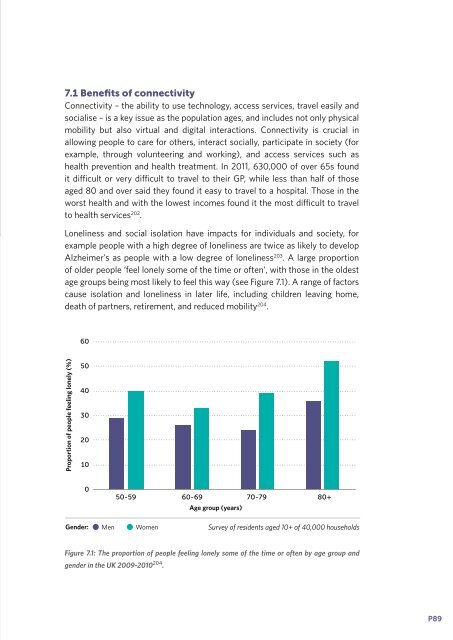Future of an Ageing Population
gs-16-10-future-of-an-ageing-population
gs-16-10-future-of-an-ageing-population
Create successful ePaper yourself
Turn your PDF publications into a flip-book with our unique Google optimized e-Paper software.
7.1 Benefits <strong>of</strong> connectivity<br />
Connectivity – the ability to use technology, access services, travel easily <strong>an</strong>d<br />
socialise – is a key issue as the population ages, <strong>an</strong>d includes not only physical<br />
mobility but also virtual <strong>an</strong>d digital interactions. Connectivity is crucial in<br />
allowing people to care for others, interact socially, participate in society (for<br />
example, through volunteering <strong>an</strong>d working), <strong>an</strong>d access services such as<br />
health prevention <strong>an</strong>d health treatment. In 2011, 630,000 <strong>of</strong> over 65s found<br />
it difficult or very difficult to travel to their GP, while less th<strong>an</strong> half <strong>of</strong> those<br />
aged 80 <strong>an</strong>d over said they found it easy to travel to a hospital. Those in the<br />
worst health <strong>an</strong>d with the lowest incomes found it the most difficult to travel<br />
to health services 202 .<br />
Loneliness <strong>an</strong>d social isolation have impacts for individuals <strong>an</strong>d society, for<br />
example people with a high degree <strong>of</strong> loneliness are twice as likely to develop<br />
Alzheimer’s as people with a low degree <strong>of</strong> loneliness 203 . A large proportion<br />
<strong>of</strong> older people ‘feel lonely some <strong>of</strong> the time or <strong>of</strong>ten’, with those in the oldest<br />
age groups being most likely to feel this way (see Figure 7.1). A r<strong>an</strong>ge <strong>of</strong> factors<br />
cause isolation <strong>an</strong>d loneliness in later life, including children leaving home,<br />
death <strong>of</strong> partners, retirement, <strong>an</strong>d reduced mobility 204 .<br />
60<br />
Proportion <strong>of</strong> people feeling lonely (%)<br />
50<br />
40<br />
30<br />
20<br />
10<br />
0<br />
50-59 60-69 70-79 80+<br />
Age group (years)<br />
Gender:<br />
Men<br />
Women<br />
Survey <strong>of</strong> residents aged 10+ <strong>of</strong> 40,000 households<br />
Figure 7.1: The proportion <strong>of</strong> people feeling lonely some <strong>of</strong> the time or <strong>of</strong>ten by age group <strong>an</strong>d<br />
gender in the UK 2009-2010 204 .<br />
P89


